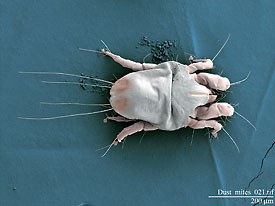A mite may never win a bug beauty pageant, but these animals’ growing impact on humans begs a closer look.
That effect is the impetus behind the new exhibit “The Invisible World of Mites.” It highlights the research of U-M biologist Barry OConnor, professor of biological sciences in the Department of Ecology and Evolutionary Biology, and curator of insects and arachnids, Museum of Zoology. The exhibit is presented in the rotunda of the Exhibit Museum of Natural History.

The new Exhibit Museum of Natural History exhibit “The Invisible World of Mites” explores tiny insects whose impact on people is underrated. Photo by Courtesy Exhibit Museum of Natural History.
OConnor has been studying the evolution and life styles of mites since he took a course about mites as a graduate student. Today, he’s particularly interested in how mites co-evolve with other organisms.
“They’re very interesting and underappreciated in terms of the impact they have on people,” OConnor says. Mites are arachnids related to spiders (both have eight legs), and are among the most diverse animals on earth. “The biggest are just a few millimeters long,” OConnor says, adding that ticks, a mite subgroup, can be several centimeters in size when engorged with blood.
OConnor says that while ticks are parasitic, as are some mites, originally mites were predators. They range in shape from round to very elongated. “The ones that are parasitic evolve body shapes that let them fit in with the bodies of their hosts,” he says. That ability is explored in the exhibit.
One way mites impact humans is by affecting food crops. “A lot of mites are agricultural pests. They affect strawberries, fruit trees and many other crops, and are vectors of viruses among cereals and grains primarily,” OConnor says.
While some mite interactions with humans are harmless, others are not. Mites cause scabies, which creates itchy patches on skin. But other mite interactions we hardly notice. “We have a two species of mites that live in our hair follicles, feeding on skin cells. They are very well-adapted parasites that most people don’t know about,” OConnor says.
The exhibit focuses particularly on dust mites, which cause allergies in humans. Dust mites have the rare ability to digest keratin, a protein found in human hair and fingernails. Keratin also is abundant in outer layers of skin. “It’s been discovered that the enzyme in the mite’s gut that breaks down the keratin is an allergen that most sensitive people react to,” OConnor says. What causes the allergic reaction is a digestive enzyme concentrated in the mites’ fecal material, he says. And, because dust mites live in huge numbers in even the cleanest homes, people constantly are surrounded by them, and their droppings.
Dust mites tend to be concentrated in peoples beds. “That’s where you’re shedding more of your skin cells; dust mite populations are there to eat the skin cells, allergens get dispersed there, and you breathe them in,” OConnor says. People who are sensitive to the allergen can experience coughing, sneezing, watery eyes and asthma. OConnor says those seeking to limit exposure to dust mites can opt for mattress covers with an extra fine weave, which has been shown to keep the allergens down.
While mites and ticks transmit pathogens that cause disease in humans, such as Lyme disease, and cause mange in animals, which causes fur loss, they do contribute some positive ecosystem services. “In soil they improve the cycling of important minerals, especially calcium. They also serve to disperse bacteria and fungi that are the main decomposers in the soil,” OConnor says.
The exhibit includes an interactive slideshow display on a video kiosk. OConnor says exhibit-goers also learn some oddities and fun things about mites. For example, “They’ve evolved the ability to ride on insects and other animals, almost like taking a bus. They can actually ride on a mouse, and then they get off in their new habitat. It’s fun looking at all the diverse places these creatures live,” he says.

